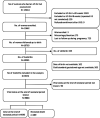Population-based rates, risk factors and consequences of preterm births in South-Asia and sub-Saharan Africa: A multi-country prospective cohort study
- PMID: 35198148
- PMCID: PMC8850944
- DOI: 10.7189/jogh.12.04011
Population-based rates, risk factors and consequences of preterm births in South-Asia and sub-Saharan Africa: A multi-country prospective cohort study
Abstract
Background: Preterm birth is the leading cause of neonatal deaths in low middle-income countries (LMICs), yet there exists a paucity of high-quality data from these countries. Most modelling estimates are based on studies using inaccurate methods of gestational age assessment. We aimed to fill this gap by measuring the population-based burden of preterm birth using early ultrasound dating in five countries in South-Asian and sub-Saharan Africa.
Methods: We identified women early in pregnancy (<20 weeks based on last menstrual period) by home visits every 2-3 months (except in Zambia where they were identified at antenatal care clinics) in 5 research sites in South-Asia and sub-Saharan Africa between July 2012 and September 2016. Trained sonographers performed an ultrasound scan for gestational age dating. Women were enrolled if they were 8-19 weeks pregnant on ultrasound. Women <8 weeks were rescheduled for repeat scans after 4 weeks, and identified women were followed through pregnancy until 6 weeks postpartum. Site-specific rates and proportions were calculated and a logistic regression model was used to predict the risk factors of preterm birth.
Results: Preterm birth rates ranged from 3.2% in Ghana to 15.7% in Pakistan. About 46% of all neonatal deaths occurred among preterm infants, 49% in South Asia and 40% in sub-Saharan Africa. Fourteen percent of all preterm infants died during the neonatal period. The mortality was 37.6% for early preterm babies (<34 weeks), 5.9% for late preterm babies (34 to <37 weeks), and 1.7% for term babies (37 to <42 weeks). Factors associated lower gestation at birth included South-Asian region (adjusted mean difference (Adj MD) = -6.2 days, 95% confidence interval (CI) = -5.5, -6.9), maternal morbidities (Adj MD = -3.4 days, 95% CI = -4.6, -2.2), multiple pregnancies (Adj MD = -17.8 days, 95% CI = -19.9,-15.8), adolescent pregnancy (Adj MD = -2.7 days, 95% CI = -3.7, -1.6) and lowest wealth quintile (Adj MD = -1.3 days, 95% CI = -2.4, -0.3).
Conclusions: Preterm birth rates are higher in South Asia than in sub-Saharan Africa and contribute to 49% and 40% of all neonatal deaths in the two regions, respectively. Adolescent pregnancy and maternal morbidities are modifiable risk factors associated with preterm birth.
Copyright © 2022 by the Journal of Global Health. All rights reserved.
Conflict of interest statement
Competing interests: The WHO and study sites received funding from the Bill and Melinda Gates Foundation (BMGF) to conduct this study. BB, CBA, DHH, JH, LH, FM, KES, MSS and JW report research grants from the BMGF during the conduct of the study. ACL reported research grants from the NICHD and BMGF. The authors completed the ICMJE Declaration of Interest form (available upon request from the corresponding authors), and declare no further conflicts of interest.
Figures
Similar articles
-
Direct maternal morbidity and the risk of pregnancy-related deaths, stillbirths, and neonatal deaths in South Asia and sub-Saharan Africa: A population-based prospective cohort study in 8 countries.PLoS Med. 2021 Jun 28;18(6):e1003644. doi: 10.1371/journal.pmed.1003644. eCollection 2021 Jun. PLoS Med. 2021. PMID: 34181649 Free PMC article.
-
Population-based rates, timing, and causes of maternal deaths, stillbirths, and neonatal deaths in south Asia and sub-Saharan Africa: a multi-country prospective cohort study.Lancet Glob Health. 2018 Dec;6(12):e1297-e1308. doi: 10.1016/S2214-109X(18)30385-1. Epub 2018 Oct 22. Lancet Glob Health. 2018. PMID: 30361107 Free PMC article.
-
Development and validation of a simplified algorithm for neonatal gestational age assessment - protocol for the Alliance for Maternal Newborn Health Improvement (AMANHI) prospective cohort study.J Glob Health. 2017 Dec;7(2):021201. doi: 10.7189/jogh.07.021201. J Glob Health. 2017. PMID: 29163937 Free PMC article.
-
Strategies for optimising antenatal corticosteroid administration for women with anticipated preterm birth.Cochrane Database Syst Rev. 2020 May 26;5(5):CD013633. doi: 10.1002/14651858.CD013633. Cochrane Database Syst Rev. 2020. PMID: 32452555 Free PMC article.
-
A Scoping Review of Preterm Births in Sub-Saharan Africa: Burden, Risk Factors and Outcomes.Int J Environ Res Public Health. 2022 Aug 24;19(17):10537. doi: 10.3390/ijerph191710537. Int J Environ Res Public Health. 2022. PMID: 36078258 Free PMC article.
Cited by
-
Identifying psychosocial predictors and developing a risk score for preterm birth among Kenyan pregnant women.BMC Pregnancy Childbirth. 2025 Jan 2;25(1):2. doi: 10.1186/s12884-024-07058-x. BMC Pregnancy Childbirth. 2025. PMID: 39748327 Free PMC article. Clinical Trial.
-
The Predictive Role of Maternal Biological Markers and Inflammatory Scores NLR, PLR, MLR, SII, and SIRI for the Risk of Preterm Delivery.J Clin Med. 2022 Nov 26;11(23):6982. doi: 10.3390/jcm11236982. J Clin Med. 2022. PMID: 36498555 Free PMC article.
-
Short- and Long-Term Consequences of Late-Preterm and Early-Term Birth.Children (Basel). 2025 Jul 9;12(7):907. doi: 10.3390/children12070907. Children (Basel). 2025. PMID: 40723099 Free PMC article. Review.
-
Influence of different methods for calculating gestational age at birth on prematurity and small for gestational age proportions: a systematic review with meta-analysis.BMC Pregnancy Childbirth. 2023 Feb 11;23(1):106. doi: 10.1186/s12884-023-05411-0. BMC Pregnancy Childbirth. 2023. PMID: 36774458 Free PMC article.
-
Global and population-specific association of MTHFR polymorphisms with preterm birth risk: a consolidated analysis of 44 studies.BMC Pregnancy Childbirth. 2025 Mar 1;25(1):230. doi: 10.1186/s12884-025-07378-6. BMC Pregnancy Childbirth. 2025. PMID: 40025425 Free PMC article.
References
-
- WHO recommended definitions, terminology and format for statistical tables related to the perinatal period and use of a new certificate for cause of perinatal deaths. Modifications recommended by FIGO as amended October 14, 1976. Acta Obstet Gynecol Scand. 1977;56:247-53. - PubMed
MeSH terms
Grants and funding
LinkOut - more resources
Full Text Sources
Miscellaneous



